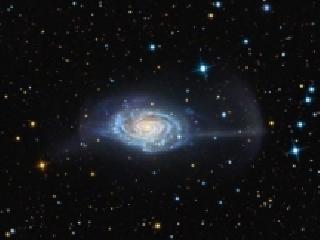
WASHINGTON (PTI): Astronomers have discovered a "dwarf" galaxy some 10 billion light-years away which they believe is consisting mainly of mysterious "dark matter".
The dwarf galaxy, only the second ever to be discovered, is incredibly distant and extremely small. It orbits as a satellite of a larger galaxy.
Though telescopes can't spot the dwarf galaxy, scientists detected its presence through the tiny distortions its gravity causes to light that passes it by.
It weighs about 190 million times the mass of the Sun - a seemingly hefty sum, although typical galaxies pack in the mass of tens of billions of suns, SPACE.com reported.
Scientists think dark matter -- which may be made of some exotic particle that doesn't reflect light -- makes up about 98 per cent of all matter in the Universe. Yet it has never been detected directly.
Discovering dark objects like this tiny, distant galaxy could help researchers understand better what dark matter is and how it affects regular matter around it, they said.
The finding, detailed in the journal Nature, suggests that the fact so few dwarf galaxies can be seen in our own cosmic neighbourhood may be explained by them being mainly composed of dark matter.
"This is the lowest mass galaxy that we've seen at this distance by far," said study co-author Matthew Auger of the University of California, Santa Barbara.
Even farther away is another galaxy whose light passes by the dark dwarf and its host on its way to Earth. As this light travels through space, it is bent by the gravity of the intervening galaxy and its satellite, causing a distorted and curved picture called an "Einstein ring". This process is called gravitational lensing.
Though most of this warping is caused by the larger gravitational tug of the host galaxy, researchers used a computer model to detect a slight excess of warping caused by the tiny addition of the dwarf satellite's gravity.
The astronomers also took help of high-resolution images taken by the Keck Observatory in Hawaii, using a system called adaptive optics to compensate for atmospheric blurring.
"The image quality in the data we used here is somewhat better than the quality you can get from the Hubble Space Telescope," Auger said.
Dwarf galaxies aren't a rarity in the cosmos; even our Milky Way has them. In fact, the newfound galaxy is about the same size as our own galaxy's Sagittarius dwarf satellite.
"For the first time we're getting information about something with a mass that's comparable to some of the smaller Milky Way satellites but outside of the local Universe," said co-author David Lagattuta of the University of California.
"Add in the fact that it's something like six or seven billion light years away, it's really true that we've never been able to see something like this before!"
The Milky Way's satellites are also little understood, as they are hard to observe, and theory predicts many more of them than have been discovered.
Scientists hope that finding more dwarf galaxies around distant hosts may help shed light on the problem.
 Previous Article
Previous Article Next Article
Next Article













The Indian Air Force, in its flight trials evaluation report submitted before the Defence Ministry l..
view articleAn insight into the Medium Multi-Role Combat Aircraft competition...
view articleSky enthusiasts can now spot the International Space Station (ISS) commanded by Indian-American astr..
view article